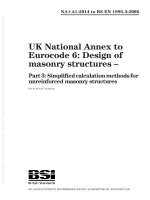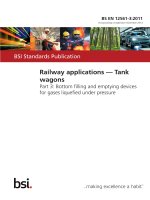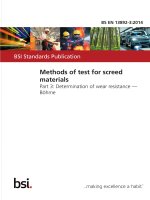Bsi bs en 61290 3 3 2014
Bạn đang xem bản rút gọn của tài liệu. Xem và tải ngay bản đầy đủ của tài liệu tại đây (1.31 MB, 22 trang )
BS EN 61290-3-3:2014
BSI Standards Publication
Optical amplifiers —
Test methods
Part 3-3: Noise figure parameters —
Signal power to total ASE power ratio
BRITISH STANDARD
BS EN 61290-3-3:2014
National foreword
This British Standard is the UK implementation of EN 61290-3-3:2014. It is
identical to IEC 61290-3-3:2013.
The UK participation in its preparation was entrusted by Technical
Committee GEL/86, Fibre optics, to Subcommittee GEL/86/3, Fibre optic
systems and active devices.
A list of organizations represented on this committee can be obtained on
request to its secretary.
This publication does not purport to include all the necessary provisions of
a contract. Users are responsible for its correct application.
© The British Standards Institution 2014.
Published by BSI Standards Limited 2014
ISBN 978 0 580 78335 7
ICS 33.180.30
Compliance with a British Standard cannot confer immunity from
legal obligations.
This British Standard was published under the authority of the
Standards Policy and Strategy Committee on 28 February 2014.
Amendments/corrigenda issued since publication
Date
Text affected
BS EN 61290-3-3:2014
EUROPEAN STANDARD
EN 61290-3-3
NORME EUROPÉENNE
EUROPÄISCHE NORM
February 2014
ICS 33.180.30
English version
Optical amplifiers Test methods Part 3-3: Noise figure parameters Signal power to total ASE power ratio
(IEC 61290-3-3:2013)
Amplificateurs optiques Méthodes d’essais Partie 3-3: Paramètres du facteur
de bruit Rapport puissance du signal sur
puissance totale d'ESA
(CEI 61290-3-3:2013)
Lichtwellenleiter-Verstärker –
Prüfverfahren Teil 3-3: Rauschzahlparameter Verhältnis der Signalleistung zur GesamtASE-Leistung
(IEC 61290-3-3:2013)
This European Standard was approved by CENELEC on 2013-12-12. CENELEC members are bound to comply
with the CEN/CENELEC Internal Regulations which stipulate the conditions for giving this European Standard
the status of a national standard without any alteration.
Up-to-date lists and bibliographical references concerning such national standards may be obtained on
application to the CEN-CENELEC Management Centre or to any CENELEC member.
This European Standard exists in three official versions (English, French, German). A version in any other
language made by translation under the responsibility of a CENELEC member into its own language and notified
to the CEN-CENELEC Management Centre has the same status as the official versions.
CENELEC members are the national electrotechnical committees of Austria, Belgium, Bulgaria, Croatia, Cyprus,
the Czech Republic, Denmark, Estonia, Finland, Former Yugoslav Republic of Macedonia, France, Germany,
Greece, Hungary, Iceland, Ireland, Italy, Latvia, Lithuania, Luxembourg, Malta, the Netherlands, Norway, Poland,
Portugal, Romania, Slovakia, Slovenia, Spain, Sweden, Switzerland, Turkey and the United Kingdom.
CENELEC
European Committee for Electrotechnical Standardization
Comité Européen de Normalisation Electrotechnique
Europäisches Komitee für Elektrotechnische Normung
CEN-CENELEC Management Centre: Avenue Marnix 17, B - 1000 Brussels
© 2014 CENELEC -
All rights of exploitation in any form and by any means reserved worldwide for CENELEC members.
Ref. No. EN 61290-3-3:2014 E
BS EN 61290-3-3:2014
EN 61290-3-3:2014
-2-
Foreword
The text of document 86C/1121/CDV, future edition 1 of IEC 61290-3-3, prepared by SC 86C, "Fibre
optic systems and active devices", of IEC/TC 86, "Fibre optics" was submitted to the IEC-CENELEC
parallel vote and approved by CENELEC as EN 61290-3-3:2014.
The following dates are fixed:
•
•
latest date by which the document has
to be implemented at national level by
publication of an identical national
standard or by endorsement
latest date by which the national
standards conflicting with the
document have to be withdrawn
(dop)
2014-09-12
(dow)
2016-12-12
Attention is drawn to the possibility that some of the elements of this document may be the subject of
patent rights. CENELEC [and/or CEN] shall not be held responsible for identifying any or all such
patent rights.
Endorsement notice
The text of the International Standard IEC 61290-3-3:2013 was approved by CENELEC as a
European Standard without any modification.
In the official version, for Bibliography, the following notes have to be added for the standards
indicated:
IEC 61290-3-1
NOTE Harmonized as EN 61290-3-1.
IEC 61290-3-2
NOTE Harmonized as EN 61290-3-2.
BS EN 61290-3-3:2014
EN 61290-3-3:2014
-3-
Annex ZA
(normative)
Normative references to international publications
with their corresponding European publications
The following documents, in whole or in part, are normatively referenced in this document and are
indispensable for its application. For dated references, only the edition cited applies. For undated
references, the latest edition of the referenced document (including any amendments) applies.
NOTE When an international publication has been modified by common modifications, indicated by (mod), the relevant EN/HD
applies.
Publication
Year
Title
EN/HD
Year
IEC 61290-3
-
Optical amplifiers - Test methods Part 3: Noise figure parameters
EN 61290-3
-
IEC 61291-1
2012
Optical amplifiers Part 1: Generic specification
EN 61291-1
2012
BS EN 61290-3-3:2014
–2–
61290-3-3 © IEC:2013
CONTENTS
1
Scope and object ............................................................................................................. 5
2
Normative references ....................................................................................................... 5
3
Terms, definitions and abbreviations ................................................................................ 5
4
3.1
Terms and definitions ......................................................................................... 5
3.2
Abbreviations ..................................................................................................... 6
Background ..................................................................................................................... 7
5
Apparatus ........................................................................................................................ 8
6
5.1
Measurement using an OSA ............................................................................... 8
5.2
Measurement using a bandpass filter and an optical power meter ....................... 9
Test sample ................................................................................................................... 11
7
Procedure ...................................................................................................................... 11
7.1
7.2
8
General ............................................................................................................ 11
Measurement using an OSA ............................................................................. 11
7.2.1
Calibration ...................................................................................... 11
7.2.2
Measurement .................................................................................. 12
7.3
Measurement using a bandpass filter and an optical power meter ..................... 13
7.3.1
General........................................................................................... 13
7.3.2
Calibration ...................................................................................... 13
7.3.3
Measurement .................................................................................. 13
Calculations ................................................................................................................... 14
9
Test results .................................................................................................................... 14
Annex A (informative) Signal power to total ASE power ratio – Dependence on signal
input power, wavelength and output power............................................................................. 15
Bibliography .......................................................................................................................... 17
Figure 1 – Test set-up for OSA calibration and for measuring signal input power and
source spontaneous emission power ....................................................................................... 8
Figure 2 – Test set-up for measuring signal output power and ASE power using an OSA.......... 8
Figure 3 – Test set-ups for filter calibration and measuring the signal input power .................. 10
Figure 4 – Test set-ups for measuring output signal power and ASE power using a filter
and an optical power meter ................................................................................................... 10
Figure A.1 – The dependence of Sig_ASE on signal input power ............................................. 15
Figure A.2 – The ASE spectrum for two different signal wavelengths ..................................... 16
Figure A.3 – Sig_ASE as a function of output power for different signal wavelength ................. 16
BS EN 61290-3-3:2014
61290-3-3 © IEC:2013
–5–
OPTICAL AMPLIFIERS –
TEST METHODS –
Part 3-3: Noise figure parameters –
Signal power to total ASE power ratio
1
Scope and object
This part of IEC 61290-3 applies to all commercially available single channel optical amplifiers
(OAs), including OAs using optically pumped fibres (OFAs) based on either rare-earth doped
fibres or on the Raman effect, semiconductor optical amplifier modules (SOA modules) and
planar optical waveguide amplifiers (POWAs). More specifically, it applies to single channel
OAs placed before optical receivers, where there are no optical bandpass filtering elements
placed between the OA and the receiver.
The object of this part of IEC 61290-3 is to establish uniform requirements for accurate and
reliable measurement of the ratio of the signal output power to the total ASE power generated
by the OA in the optical bandwidth of the receiver. This quantity is a measure of the
spontaneous-spontaneous beat noise at the receiver, and is correlated to the spontaneousspontaneous noise factor of the OA, F sp-sp , as defined in IEC 61290-3 and IEC 61291-1.
IEC 61290-3-1 describes a measurement method, using an optical spectrum analyzer, OSA, for
the signal-spontaneous noise factor Fsig− s p but does not describe a method for measuring
F sp-sp . IEC 61290-3-2 describes a measurement method, using an electrical spectrum analyzer
(ESA), for the total noise factor F sp-sp + F sig-sp . However, this method does not allow F sp-sp to
be measured separately, and therefore does not provide a means of directly quantifying the
effect of spontaneous-spontaneous beat noise at the receiver. This part of IEC 61290-3
complements IEC 61290-3-1 and IEC 61290-3-2 in that it provides such a means.
Two measurement methods are provided for the ratio of the signal output power to the total
ASE power. The first method uses an OSA, while the second method uses a bandpass filter
and an optical power meter.
2
Normative references
The following documents, in whole or in part, are normatively referenced in this document and
are indispensable for its application. For dated references, only the edition cited applies. For
undated references, the latest edition of the referenced document (including any amendments)
applies.
IEC 61290-3, Optical amplifiers – Test methods – Part 3: Noise figure parameters
IEC 61291-1:2012, Optical fibre amplifiers – Part 1: Generic specification
3
3.1
Terms, definitions and abbreviations
Terms and definitions
For the purposes of this document, the following terms and definitions apply.
BS EN 61290-3-3:2014
–6–
61290-3-3 © IEC:2013
3.1.1
signal input power
P in
power of the optical signal at the input to the OA
3.1.2
signal output power
P out
power of the optical signal at the output of the OA
3.1.3
signal wavelength
λs
wavelength of the signal optical carrier
[SOURCE: IEC 61291-1:2012, definition 3.2.2.1.1]
3.1.4
signal gain
G
gain of the OA at the signal wavelength, defined as the ratio of the output signal power to the
input signal power
3.1.5
amplified spontaneous emission band
ASE band
B ASE
wavelength band that contains at least 99 % of the total ASE power generated by OA
3.1.6
ASE centre wavelength
λC
centre wavelength of the ASE band
3.1.7
ASE power
P ASE
ASE power generated by the OA within the ASE band
3.1.8
signal to total ASE power ratio
Sig_ASE
ratio of the output signal power to the total ASE power within B ASE
3.1.9
spontaneous–spontaneous noise factor
F sp-sp
ratio of the electrical SNR due to spontaneous-spontaneous beat noise at the OA output to the
electrical SNR due to shot noise at the OA input
Note 1 to entry: See also IEC 61290-3 for a detailed formula for of F sp-sp .
3.2
Abbreviations
APD
avalanche photo diode
AFF
ASE flattening filter
ASE
amplified spontaneous emission
BS EN 61290-3-3:2014
61290-3-3 © IEC:2013
–7–
CD
chromatic dispersion
DFB
distributed feedback
EDFA
erbium-doped fibre amplifier
ESA
electrical spectrum analyzer
FWHM
full width half maximum
NF
noise figure
OA
optical amplifier
OFA
optical fibre amplifier
OSA
optical spectrum analyzer
PDG
polarization dependent gain
PMD
polarization mode dispersion
POWA
planar optical waveguide amplifier
RBW
resolution band width
SNR
signal to noise ratio
SOA
semiconductor optical amplifier
VOA
variable optical attenuator
WDM
wavelength division multiplexing
4
Background
In recent years, high-speed transmission links beyond 10 Gb/s have been commercially
introduced. These links (as well as some high-end 10-Gb/s links, such as submarine links)
require high sensitivity receivers, e.g. avalanche photo diode (APD) receivers, which operate in
a limited input optical power dynamic range. In addition, specialized optical components such
as chromatic dispersion (CD) compensators and polarization mode dispersion (PMD)
compensators may be placed on the receiver module, thus introducing considerable optical
insertion loss.
In multi-channel wavelength division multiplexed (WDM) links a multi-channel OA is often
placed at the end of the link before the WDM signal is demultiplexed into individual channels.
The total output power of the multi-channel OA is typically such that the optical power per
channel is in the range of 0 dBm to 5 dBm. This power is then attenuated by the demultiplexer,
and further attenuated by the specialized optical components mentioned above. Thus, the
optical power reaching the receiver may be below the required input optical power dynamic
range. In this case, a single channel OA may be placed on the receiver module to boost the
optical power reaching the receiver.
In such a situation, there is typically no optical bandpass filter between the single channel OA
and the receiver, so that all the amplified spontaneous emission (ASE) noise generated by the
amplifier reaches the receiver. This can result in a significant level of spontaneousspontaneous beat noise at the receiver. One way to characterize this noise is through the
spontaneous-spontaneous noise factor, F sp-sp , as defined in IEC 61290-3 and IEC 61291-1.
Another way to characterize the spontaneous-spontaneous beat noise is through the signal to
total ASE power ratio, Sig_ASE, at the OA output, given by the following:
Sig _ ASE =
Pout
PASE
(1)
where P out is the signal output power of the OA, and P ASE is the ASE power generated by the
OA within the ASE band, given by
BS EN 61290-3-3:2014
–8–
PASE =
∫B
ASE
61290-3-3 © IEC:2013
ρ ASE (λ )dλ
(2)
where B ASE is the ASE band of the OA defined as a wavelength band that contains at least
99 % of the total ASE power generated by OA.
Care should be taken to define B ASE such that it excludes other sources of noise not related to
ASE. In particular, B ASE should exclude possible pump leakage power exiting the OA output
port. For example, for a C-band EDFA pumped by a 1 480 nm pump, B ASE should not include
wavelengths below 1 500 nm. This guarantees that B ASE includes at least 99 % of the ASE
generated within the EDFA on the one hand, while excluding possible 1 480 nm pump leakage
power on the other.
NOTE 1 In many OAs, and especially in OFAs, the ASE is polarization independent. In some OAs, such as some
types of SOA modules, the ASE may be polarization dependent. P ASE refers to the total power in both polarization
directions.
While there is no direct relation between Sig_ASE and F sp-sp , it is clear that there is a
correlation between them, and that both quantities can be used to quantify the effect of
spontaneous-spontaneous beat noise at the receiver. The higher is Sig_ASE, the lower is the
spontaneous-spontaneous beat noise (and the lower F sp-sp ), and vice-versa.
In this standard, a measurement method for Sig_ASE is presented. Annex A provides a brief
technical discussion of the various OA parameters that can affect and determine the Sig_ASE
value.
NOTE 2
5
All quantities in this standard are in linear units, unless specifically defined otherwise.
Apparatus
5.1
Measurement using an OSA
This subclause describes the apparatus used for measuring Sig_ASE using an OSA. Figure 1
shows the test set-up used for OSA calibration, as well as for measuring the signal input power
and the source spontaneous emission power. Figure 2 shows the test set-up used to measure
the signal output power and the ASE power.
Laser
source
VOA
Polarization
controller
OSA
IEC
2660/13
Figure 1 – Test set-up for OSA calibration and for measuring signal input power and
source spontaneous emission power
Laser
source
VOA
Polarization
controller
OA
OSA
IEC
2661/13
Figure 2 – Test set-up for measuring signal output power and ASE power using an OSA
BS EN 61290-3-3:2014
61290-3-3 © IEC:2013
–9–
The test equipment listed below, with the required characteristics, is needed.
a) A laser source with the following characteristics:
1) Either a tuneable laser or a set of discrete lasers able to support the range of signal
wavelengths for which the OA under test is to be tested.
2) An achievable output power such that the input signal power to the OA under test is
above the maximum specified input signal power.
3) A single line output with a side mode suppression ratio of at least 40 dB.
4) A FWHM linewidth <0,01 nm.
5) Output power stability <0,05 dB.
b) VOA – A variable optical attenuator (VOA) with a dynamic range sufficient to support the
required range of input signal power levels at which the OA under test is to be tested. The
reflectance from each port of the device should be <–50 dB.
NOTE 1 If the output power of the laser source can be varied over the required dynamic range, then the VOA
may not be needed.
c) Polarization controller – a device capable of transforming any input polarization state to any
output polarization state. The reflectance from each port of the device should be <–50dB.
NOTE 2 If the polarization dependent gain (PDG) of the an OFA or POWA is <0,3 dB, the polarization
controller may not be needed.
d) OSA – the OSA shall have the following characteristics:
1) Polarization sensitivity less than 0,1dB.
2) Power stability better than 0,1dB.
3) Wavelength accuracy better than 0,05 nm.
4) The resolution bandwidth (RBW) of the OSA should be set to a value in the range of
0,2 nm to 1 nm, preferably 0,5 nm.
5) Reflectance from the input port of the OSA should be <–50 dB.
5.2
Measurement using a bandpass filter and an optical power meter
This subclause describes the apparatus used for measuring Sig_ASE using a filter and an
optical power meter. Figure 3 shows the test set-up used for the filter insertion loss calibration,
as well as for measuring the signal input power. Figure 4 shows the test set-up used to
measure the signal output power and the ASE power. This measurement method does not
allow for the measurement of the laser source spontaneous emission, thus requiring a laser
source with low enough spontaneous emission so as not to affect the Sig_ASE measurement
(see laser source requirements below).
In cases where the OA may emit power outside of B ASE (for example, pump leakage in the
case of an amplifier employing 1 480 nm pumps), then a filter should be placed before the
optical power meter to filter out such unwanted components. Such a filter should have an
insertion loss ripple of <0,5 dB over B ASE , and should have an extinction ratio of at least 30 dB
(relative to the insertion loss within B ASE ) for the unwanted wavelength components. This filter
should be placed before the optical power meter in Figure 3 and Figure 4.
BS EN 61290-3-3:2014
– 10 –
Laser
source
61290-3-3 © IEC:2013
Optical
power
meter
Polarization
controller
VOA
IEC
2662/13
Figure 3a – Test set-up without bandpass filter
Laser
source
Bandpass
filter
Polarization
controller
VOA
Optical
power
meter
IEC
2663/13
Figure 3b – Test set-up with bandpass filter
Figure 3 – Test set-ups for filter calibration and measuring the signal input power
Laser
source
Polarization
controller
VOA
OA
Optical
power
meter
IEC
2664/13
Figure 4a – Test set-up without bandpass filter
Laser
source
VOA
Polarization
controller
OA
Bandpass
filter
Optical
power
meter
IEC
2665/13
Figure 4b – Test set-up with bandpass filter
Figure 4 – Test set-ups for measuring output signal power and ASE
power using a filter and an optical power meter
The test equipment listed below, with the required characteristics, is needed.
a) A laser source with the following characteristics:
1) Either a tuneable laser or a set of discrete lasers able to support the range of signal
wavelengths for which the OA under test is to be tested.
2) An achievable output power such that the input signal power to the OA under test is
above the maximum specified input signal power.
3) A single line output with a side mode suppression ratio of at least 40 dB.
4) A total spontaneous emission power within B ASE which is at least X + 20 dB less than
the laser output power, where X is the lowest specified Sig_ASE ratio of the OA.
5) A FWHM linewidth <0,01 nm.
6) Output power stability <0,05 dB.
b) VOA – A variable optical attenuator (VOA) with a dynamic range sufficient to support the
required range of input signal power levels at which the OA under test is to be tested. The
reflectance from each port of the device should be <–50 dB.
NOTE 2 If the output power of the laser source can be varied over the required dynamic range, then the VOA
may not be needed.
BS EN 61290-3-3:2014
61290-3-3 © IEC:2013
– 11 –
c) Polarization controller – a device capable of transforming any input polarization state to any
output polarization state. The reflectance from each port of the device should be <–50 dB.
NOTE 3 If the polarization dependent gain (PDG) of an OFA or POWA is <0,3 dB, the polarization controller
may not be needed.
d) A bandpass filter with the following characteristics:
1) Either a tuneable filter or a set of discrete filters with centre wavelengths corresponding
to the range of signal wavelengths for which the OA under test is to be tested.
2) 1–dB passband of at least ±20 GHz around the centre wavelength
3) At least 20 dB attenuation level below the centre wavelength insertion loss for all
wavelengths within B ASE except a range of ±100 GHz centred around the centre
wavelength.
e) Optical power meter – should have a measurement accuracy of better than ±0,2 dB,
irrespective of the signal polarization state.
6
Test sample
The OA shall be tested at nominal operating conditions. If the OA is likely to cause laser
oscillations due to unwanted reflections, optical isolators should be used to bracket the OA
under test. This will minimize the signal instability and the measurement inaccuracy.
Care shall be taken in maintaining the state of polarization of the input signal during the
measurement. Changes in the polarization state of the input signal may result in input optical
power changes because of the slight polarization dependency expected from all the used
optical components, leading to measurement errors.
7
Procedure
7.1
General
The measurement procedure includes the measurement of the following parameters:
•
•
output signal power – P out
ASE power – P ASE
In order to measure P ASE , it may be necessary to measure the source spontaneous emission
power, P SSE of the laser source, as well as the OA gain, G. P ASE is then determined by
subtracting GP SSE from the total measured noise power at the OA output. The measurement of
P SSE need not be carried out if care is taken to ensure that it is small enough so as not to
affect the measurement of Sig_ASE (see 5.2, a) 4).
7.2
Measurement using an OSA
This subclause describes the procedure used for measuring Sig_ASE using an OSA.
7.2.1
7.2.1.1
Calibration
Calibration of optical bandwidth of the OSA
The optical bandwidth B OSA of the OSA should be accurately calibrated for the RBW at which
the measurement is to be performed. This is needed in order to measure the optical power
density at each wavelength, and thus the integrated optical power within any desired
wavelength band.
NOTE 1 Some OSAs include an automatic function for measuring the integrated optical power in any desired
wavelength band. In such cases, it is not necessary to perform this calibration.
BS EN 61290-3-3:2014
– 12 –
61290-3-3 © IEC:2013
To calibrate the optical bandwidth of the OSA, perform the following steps:
a) Connect the test set-up as shown in Figure 1.
b) Set the wavelength of the laser source to λ c , the centre of the ASE band.
c) Set the OSA centre wavelength to λ c .
d) Set the OSA span to zero.
e) Measure the optical power P(λ c ).
f) Set the laser source to a series of wavelengths λ i to cover the wavelength range [λ c –
5 RBW, λ c + 5 RBW], where the interval ∆λ i between wavelengths should be smaller than
RBW /5. At each wavelength, measure the optical power, P(λ i ).
g) Determine the optical bandwidth of the OSA according to the following formula:
BOSA =
7.2.1.2
1
P (λC )
∑ P(λi )∆λi
i
(3)
Calibration of OSA power calibration factor
Follow the steps listed below to calibrate the OSA power calibration factor, P Cal . This factor
calibrates the OSA for absolute power.
NOTE 2
If the OSA has already been calibrated for absolute power, this calibration step is not required.
a) Connect the test set-up as shown in Figure 1.
b) Set the wavelength of the laser source to λ c , the centre of the ASE band.
c) Set the OSA centre wavelength to λ c .
d) Measure the optical power at λ c , P OSA .
e) Disconnect the OSA, and connect instead a calibrated power meter.
Measure the optical power P PM.
g) Determine the OSA power calibration factor according to the following formula:
f)
P Cal = P PM/P OSA
7.2.2
(4)
Measurement
Follow the steps listed below to perform the measurement:
a) Connect the test set-up as shown in Figure 1.
b) Set the wavelength of the laser source to the required signal wavelength, λ s .
c) Set the VOA such that the signal input power is at the required level.
d) Set the span of the OSA to cover the ASE band.
e) Measure the OSA power at the signal wavelength, P(λ s ), and determine the signal input
power as P in = P(λ s )×P Cal .
f)
Measure the optical power at all wavelengths λ i in the ASE band with a resolution of at least
RBW/5. For each wavelength calculate the optical power density as ρ(λ i ) = P(λ i )/B OSA .
g) Measure the total optical power in the ASE band according to the following formula:
PTot =
∑ ρ (λi )∆λi
i
h) Determine the source spontaneous emission power as P SSE = P Tot × P Cal – P In .
(5)
BS EN 61290-3-3:2014
61290-3-3 © IEC:2013
– 13 –
i)
Connect the test set-up as shown in Figure 2.
j)
Operate the OA at the required operating conditions.
k) Measure the OSA power at the signal wavelength, P(λ s ), and determine the signal output
power as P out = P(λ s ) × P Cal .
l)
Determine the signal gain as G = P out /P in .
m) Measure the optical power at all wavelengths λ i in the ASE band with a resolution of at least
RBW/5. For each wavelength calculate the optical power density as ρ(λ i ) = P(λ i )/B OSA .
n) Measure the total optical power in the ASE band according to the following formula:
PTot =
∑ ρ (λi )∆λi
i
(6)
o) Determine the ASE power as
PASE = PCal PTot − Pout − GPSSE
(7)
NOTE 1 Some OSA may contain an internal integration function that automatically calculates the integrated optical
power in a given wavelength band. In this case, steps f), g), m) and n) may be performed using this automatic
function.
NOTE 2 The use of the signal gain G to calculate the amplified source spontaneous emission at the OA output
may not be totally accurate, since the amplifier gain may be wavelength dependent. However, there are two factors
in favour of using this approximation: 1) When an OA is designed to minimize Sig_ASE, the gain is typically quite flat
within the wavelength band that contributes the most to P ASE ; 2) When Sig_ASE is at its worst, this usually means
that G is smaller than the gain at most points within the wavelength band that contributes the most to P ASE . Thus,
the amplified source spontaneous emission is slightly under-estimated, and P ASE slightly over estimated. This
means that the worst measured Sig_ASE can be viewed as a lower limit to the real Sig_ASE over all operating
conditions of the OA.
7.3
7.3.1
Measurement using a bandpass filter and an optical power meter
General
This subclause describes the procedure used for measuring Sig_ASE using a bandpass filter
and an optic power meter.
7.3.2
Calibration
Follow the procedure listed below to calibrate the bandpass filter insertion loss:
a) Connect the test set-up as shown in Figure 3a.
b) Set the wavelength of the laser source to the required signal wavelength, λ s .
c) Measure the optical power without the bandpass filter, P 0 , using the optical power meter.
d) Insert the bandpass filter as shown in Figure 3b, with the centre wavelength of the filter
equal to λ s .
e) Measure the optical power with the bandpass filter, P 1 , using the optical power meter.
f) Determine the filter insertion loss at the signal wavelength as
ILF (λS ) = P1 / P0
7.3.3
Measurement
Follow the steps listed below to perform the measurement:
a) Connect the test set-up as shown in Figure 3(a).
b) Set the wavelength of the laser source to the required signal wavelength, λ s .
(8)
BS EN 61290-3-3:2014
– 14 –
61290-3-3 © IEC:2013
c) Set the VOA such that the signal input power is at the required level.
d) Measure the signal input power P in using the optical power meter.
e) Insert the OA as shown in Figure 4a.
f)
Operate the OA at the required operating conditions
g) Measure the total OA output power, P Tot , using the optical power meter.
h) Insert the bandpass filter as shown in Figure 4b, with the centre wavelength of the filter
equal to λ s .
i)
j)
Measure the optical power with the bandpass filter, P 2 , using the optical power meter.
Determine the signal output power as P out = P 2 /IL F (λ s ).
k) Determine the ASE power as P ASE = P Tot – P out .
8
Calculations
Sig_ASE may be calculated from Formula (3) using P out and P ASE . Note that as with all values
and calculations presented in this standard, the values are calculated in linear units. They may
be transferred to dB as required.
9
Test results
Sig_ASE shall be measured for all combinations of signal wavelengths, signal input power levels
and OA signal gain levels so as to cover the OA operating range sufficiently, as set in the OA
specifications. If the PDG of the OA is above 0,3 dB, then at each operating point a polarization
controller should be set to obtain the lowest value of Sig_ASE.
At a minimum, the worst case result for Sig_ASE shall be provided, along with the signal
wavelength, input power level, and OA gain level at which this result was measured.
BS EN 61290-3-3:2014
61290-3-3 © IEC:2013
– 15 –
Annex A
(informative)
Signal power to total ASE power ratio –
Dependence on signal input power, wavelength and output power
Most OAs are designed to minimize the noise figure (NF), which is related to the ASE in the
vicinity of the signal wavelength. However, when designing a single channel OA to be placed
on a receiver module, it is desirable to increase the signal power to total ASE power ratio
(Sig_ASE) as much as possible in order to improve the receiver performance. This means that
the total ASE of the OA should be minimized, and not just the ASE in the vicinity of the signal
channel. This annex provides a brief technical discussion of the various OA parameters that
can affect and determine Sig_ASE.
Sig_ASE (dB)
The main parameter that affects Sig_ASE is the signal input power. In a typical application, the
OA is designed to operate in automatic power control (APC) mode to provide constant signal
output power to the receiver. This means that the gain of the amplifier depends on the signal
input power. The higher the signal input power, the lower the required gain in order to achieve
the desired operating signal output power. Since the ASE power is approximately proportional
to the gain, this means that for a given signal output power, Sig_ASE will be increased
approximately proportionally with the signal input power. At high signal input power (low gain),
the ASE ceases to be proportional to the signal input power, and instead is determined by the
signal output power. Thus, at high signal input power the Sig_ASE increases at a slower rate.
An example of the dependence of Sig_ASE on signal input power is shown in Figure A.1
20
18
16
14
12
10
8
6
4
2
0
–24 –22 –20 –18 –16 –14 –12 –10 –8
–6
Signal input power (dBm)
–4
–2 0
IEC 2666/13
Figure A.1 – The dependence of Sig_ASE on signal input power
If the single channel OA is specified to operate over a wavelength band, and not just at a
specific wavelength, then Sig_ASE can also depend on the signal wavelength. For a wider
operating wavelength band, the ASE is likely to be less uniform over the band, and wavelength
dependence of Sig_ASE will be stronger. This is illustrated in Figure A.2, which shows the ASE
spectrum for two different signal wavelengths at opposite ends of the C-band. In both cases
the signal input and output power are the same, however as can be clearly seen, the Sig_ASE
ratio is significantly lower in the case of a 1 564 nm signal.
BS EN 61290-3-3:2014
– 16 –
61290-3-3 © IEC:2013
Spectral power/0,2 nm (dBm)
10
5
0
Signal = 1 531 nm
–5
Signal = 1 564 nm
–10
–15
–20
–35
–30
1 530
NOTE
1 535 1 540 1 545 1 550 1 555
Signal wavelength (nm)
1 560
1 565
IEC 2667/13
In both the cases the signal input and output powers are the same.
Figure A.2 – The ASE spectrum for two different signal wavelengths
In order to flatten Sig_ASE over the specified operating wavelength band, an ASE flattening
filter (AFF) can be used. This filter is typically designed such that at the optimal operating
signal input and output power, in other words at the optimal signal gain, the Sig_ASE is
substantially flat as a function of signal wavelength. However, when the operating conditions
(signal input and/or output power) differ from the optimal values, then the Sig_ASE becomes
tilted. This effect is illustrated in Figure A.3, which shows Sig_ASE for a constant signal input
power and varying output power for two different signal wavelengths at either end of the Cband. When the signal output power is higher than optimal, Sig_ASE at 1 531 nm increases,
and Sig_ASE at 1 564 nm decreases. When the signal output power is lower than optimal, the
opposite behaviour occurs.
10
Sig_ASE (dB)
9
8
7
1 531 nm
6
1 564 nm
5
2
3
4
5
6
7
8
Signal output power (dBm)
9
10
IEC 2668/13
NOTE A gain-flattening filter, GFF, is used to achieve flat Sig_ASE as a function of wavelength for the optimal
signal output power (in this case 6 dBm).
Figure A.3 – Sig_ASE as a function of output power for different signal wavelength
BS EN 61290-3-3:2014
61290-3-3 © IEC:2013
– 17 –
Bibliography
IEC 61290-3-1, Optical amplifiers – Test methods – Part 3-1: Noise figure parameters – Optical
spectrum analyzer method
IEC 61290-3-2, Optical amplifiers – Test methods – Part 3-2: Noise figure parameters –
Electrical spectrum analyzer method
_____________
This page deliberately left blank
This page deliberately left blank
NO COPYING WITHOUT BSI PERMISSION EXCEPT AS PERMITTED BY COPYRIGHT LAW
British Standards Institution (BSI)
BSI is the national body responsible for preparing British Standards and other
standards-related publications, information and services.
BSI is incorporated by Royal Charter. British Standards and other standardization
products are published by BSI Standards Limited.
About us
Revisions
We bring together business, industry, government, consumers, innovators
and others to shape their combined experience and expertise into standards
-based solutions.
Our British Standards and other publications are updated by amendment or revision.
The knowledge embodied in our standards has been carefully assembled in
a dependable format and refined through our open consultation process.
Organizations of all sizes and across all sectors choose standards to help
them achieve their goals.
Information on standards
We can provide you with the knowledge that your organization needs
to succeed. Find out more about British Standards by visiting our website at
bsigroup.com/standards or contacting our Customer Services team or
Knowledge Centre.
Buying standards
You can buy and download PDF versions of BSI publications, including British
and adopted European and international standards, through our website at
bsigroup.com/shop, where hard copies can also be purchased.
If you need international and foreign standards from other Standards Development
Organizations, hard copies can be ordered from our Customer Services team.
Subscriptions
Our range of subscription services are designed to make using standards
easier for you. For further information on our subscription products go to
bsigroup.com/subscriptions.
With British Standards Online (BSOL) you’ll have instant access to over 55,000
British and adopted European and international standards from your desktop.
It’s available 24/7 and is refreshed daily so you’ll always be up to date.
You can keep in touch with standards developments and receive substantial
discounts on the purchase price of standards, both in single copy and subscription
format, by becoming a BSI Subscribing Member.
PLUS is an updating service exclusive to BSI Subscribing Members. You will
automatically receive the latest hard copy of your standards when they’re
revised or replaced.
To find out more about becoming a BSI Subscribing Member and the benefits
of membership, please visit bsigroup.com/shop.
With a Multi-User Network Licence (MUNL) you are able to host standards
publications on your intranet. Licences can cover as few or as many users as you
wish. With updates supplied as soon as they’re available, you can be sure your
documentation is current. For further information, email
BSI Group Headquarters
389 Chiswick High Road London W4 4AL UK
We continually improve the quality of our products and services to benefit your
business. If you find an inaccuracy or ambiguity within a British Standard or other
BSI publication please inform the Knowledge Centre.
Copyright
All the data, software and documentation set out in all British Standards and
other BSI publications are the property of and copyrighted by BSI, or some person
or entity that owns copyright in the information used (such as the international
standardization bodies) and has formally licensed such information to BSI for
commercial publication and use. Except as permitted under the Copyright, Designs
and Patents Act 1988 no extract may be reproduced, stored in a retrieval system
or transmitted in any form or by any means – electronic, photocopying, recording
or otherwise – without prior written permission from BSI. Details and advice can
be obtained from the Copyright & Licensing Department.
Useful Contacts:
Customer Services
Tel: +44 845 086 9001
Email (orders):
Email (enquiries):
Subscriptions
Tel: +44 845 086 9001
Email:
Knowledge Centre
Tel: +44 20 8996 7004
Email:
Copyright & Licensing
Tel: +44 20 8996 7070
Email:









